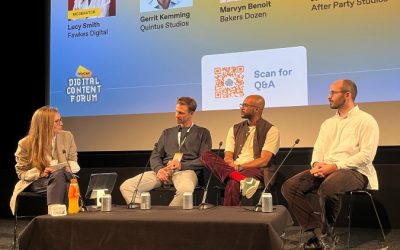The creativity in the social-video sphere is being bankrolled by a new generation of investors… but what do they want, and how do they see the industry’s future? A panel at TellyCast’s Digital Content Forum 2025 this week found out. Moderated by Avalon Advisory’s Daniel Winner, the panel included Lunar X’s Indi Sunner, Viewture’s Jason Kingston-Brown and Electrify’s Claire Geddie.
“Institutional investors are coming in now because they understand it’s measurable. They look at creators as media businesses,” said Kingston-Brown. “It’s a real opportunity to invest in a business now… They can see data, analytics and long-term revenue.”
Geddie built on this by explaining that “the promise of owning an audience is something that we’re really excited about, and more direct-to-fan opportunities”. For example, something that pings her investor-radar is when creators running a YouTube channel also have a burgeoning subscription income from Patreon or Substack.
“We operate much more in a 1,000 true fans model: we want to see that there’s a really dedicated group of fans that are to some extent portable [to other ways to make money],” she said.
When it comes to investing in digital-first producers, Geddie is looking for founders operating successful, profitable businesses – “around the seven-figure [profit] level would be ideal” – as well as with companies with “clear headroom” for growth through high-quality, evergreen IP.
Before Lunar X, Sunner worked at Moonbug Entertainment, which rolled up a number of children’s-entertainment YouTube channels before being itself acquired by a huge private-equity firm. He said this deal gave the wider sector more credibility in the eyes of investors.
“It’s proven that these businesses can generate return for investors if they are operated well,” said Sunner. “If the investments are done with data in mind… there is very much a possibility for investors to make a return on capital in what is a highly-dynamic investment environment.”
Geddie talked valuations, suggesting that acquirers are willing to pay between 3x and 6x of a company’s profit. “And we are looking at the growth rate, which is really important in where the multiple sits within that,” she added.
Financial metrics aren’t the only things that count, however. “We have the financial KPIs, but also the operational KPIs, focusing on the YouTube metrics,” said Sunner. “And the engagement is really key. Making sure you have good engagement from your audience is really how you’re going to be able to tap into those additional revenue streams.”
Kingston-Brown warned that investors are placing their bets carefully rather than adopting a “spray and pray” approach. He also noted that there can be inflated expectations from creators about how much they might be worth. “Some of them have three followers and want a million pounds, which is interesting!”
The panel finished with each speaker suggesting how digital-first companies can make themselves investor-ready.
“Either lead your niche, or make the operations not overly reliant on yourself as an individual,” said Sunner. Meanwhile, Kingston-Brown advised creators to “think like an entrepreneur, and set yourself up as a business.”
Geddie had the last word, suggesting that consistency in financial metrics, as well as content quality, may be key. “See if you can establish your profitability around recurring revenues that aren’t spiky,” she said.





